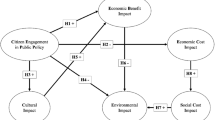Abstract
Typhoon Morakot hit Taiwan in 2009, severely damaging the Alishan National Forest Recreation Area, a famous tourist resort in Taiwan. The only highway to this area was under repair for 10 months after the typhoon. Consequently, Alishan’s tourism industry suffered losses estimated at NT$1 billion. This work investigates the impacts of natural hazards on Taiwan’s tourism industry. First, government, university, and industry experts were invited to a focus-group interview to update criteria for tourism development in Taiwan. Next, the Analytic Hierarchy Process (AHP) was applied to rank the proposed criteria. Last, two tourist attractions, one urban and one rural, are discussed in detail. This work proposes three novel dimensions for Taiwan’s tourism development—destination attraction, destination arrangement, and contingency planning for natural hazards—which comprise nine criteria. Analytical results will provide Taiwan’s tourism industry with references for future policy-making and sustainable development.



Similar content being viewed by others
References
Blank U (1989) The community tourism industry imperative: the necessity, the opportunity and its potential. Venture Publishing, State College
Buhalis D (2000) Marketing the competitive destination of the future. Tour Manag 21(1):97–116
Central Weather Bureau (CWB) (2011) Typhoons affecting Taiwan: analysis and forecast aids. http://rdc28.cwb.gov.tw/data.php. Accessed 1 Mar 2011
Coiccio L, Michael EJ (2007) Hazard or disaster: tourism management for the inevitable in Northeast Victoria. Tour Manag 28(1):1–11
Crouch GI, Ritchie JR (1999) Tourism competitiveness and societal prosperity. J Bus Res 44(3):137–152
Directorate General of Budget, Accounting and Statistics (DGBAS) (2011) http://www.dgbas.gov.tw/ct.asp?xItem=15466&CtNode=4680&mp=1. Accessed 28 Feb 2011
Dwyer L, Mellor R, Livaic Z, Edwards D, Kim C (2004) Attributes of destination competitiveness: a factor analysis. Tour Anal 9(1–2):91–101
Go F, Govers R (2000) Integrated quality management for tourist destinations: a European perspective on achieving competitiveness. Tour Manag 21(1):79–88
Gunn CA (1997) Vacationscape: developing tourist areas, 3rd ed. Taylor & Francis
Heath E, Wall G (1992) Marketing tourism destination: a strategic planning approach. Wiley, Canada
Johnston D, Paton D, Crawford GL, Ronan K, Houghton B, Burgelt P (2005) Measuring tsunami preparedness in coastal Washington, United States. Nat Hazards 35(2):173–184
Kotler P, Bowen J, Makens J (2005) Marketing for hospitality and tourism. Pearson Education, NY
Mihalic T (2000) Environmental management of a tourist destination: a factor of tourism competitiveness. Tour Manag 21(1):65–78
Saaty TL (1980) The analytic hierarchy process. McGraw-Hill, New York
Saaty TL (1990) How to make a decision: the analytic hierarchy process. Eur J Oper Res 48(1):9–26
Taiwan Tourism Bureau (2009a) 2010. http://admin.taiwan.net.tw/indexc.asp. Accessed 1 Feb 2011
Taiwan Tourism Bureau (2009b) 2009 Annual survey report on visitors expenditure and trends in Taiwan. http://admin.taiwan.net.tw/statistics/market.asp?relon=11. Accessed 1 Feb 2011
Taiwan Tourism Bureau (TTB) (2002) The conference of doubling tourists arrival plan. http://www.tbroc.gov.tw/doublep/double.htm#a. Accessed 12 Jan 2011
Tsai HT, Tzeng SY, Fu HH, Wu CT (2009) Managing multinational sustainable development in the European Union based on the DPSIR framework. Afr J Bus Manag 3(11):727–735
Water Resources Agency, Ministry of Economic Affairs (WRAMEA) (2011) http://www.wra.gov.tw. Accessed 26 Feb 2011
World Travel & Tourism Council (2011) http://www.wttc.org/. Accessed 3 Jul 2011
Yu G, Schwartz Z, Walsh JE (2009) A weather-resolving index for assessing the impact of climate change on tourism related climate resources. Clim Change 95(3–4):551–573
Author information
Authors and Affiliations
Corresponding author
Rights and permissions
About this article
Cite this article
Tsai, HT., Tseng, CJ., Tzeng, SY. et al. The impacts of natural hazards on Taiwan’s tourism industry. Nat Hazards 62, 83–91 (2012). https://doi.org/10.1007/s11069-011-0034-z
Received:
Accepted:
Published:
Issue Date:
DOI: https://doi.org/10.1007/s11069-011-0034-z




